The right camera for my application
Imaging involves complex interactions between the material and surface characteristics of the test object, optics, lighting and, last but not least, the camera used. Here, the image is captured by the sensor, processed and then digitised. The required accuracy and speed of testing, as well as the application's requirements in terms of the image sensor, combine to determine the choice of camera.
Typical camera types in industrial image processing include:
- Matrix cameras: Using a matrix-shaped sensor, a two-dimensional image is captured simultaneously and then sent to a PC, etc., where it is analysed.
- Line scan cameras: A single linear sensor array captures a large number of individual lines in rapid succession. A two-dimensional image is generated from the feed motion of the conveyor belt or camera unit, and sent to a PC, etc. This procedure is ideal for recording continuous materials, etc.
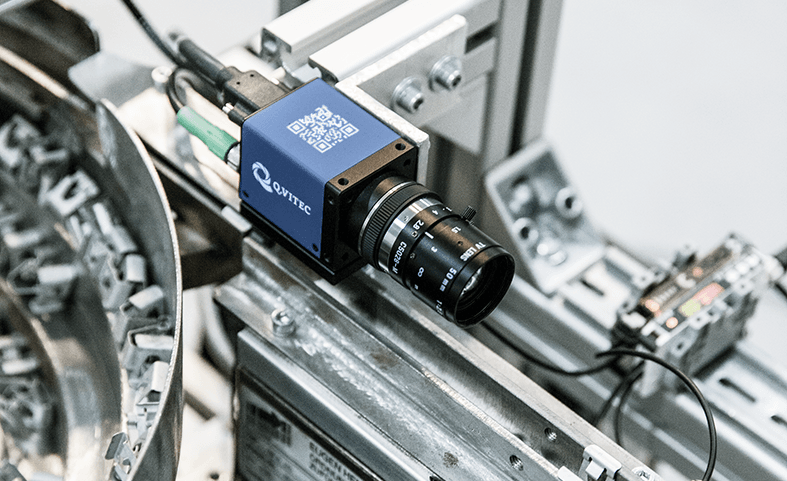
Selecting a suitable camera type
The choice of camera is generally determined by the testing task. The characteristics to be captured must be represented properly so that the software can analyse them. But what does this actually mean?
- Area scan camera or line scan camera: Will the components be arriving separately, or is it a material that is being transported? In the simplest case, images are captured using an area scan camera working continuously or in cycles. Using a line scan camera, it is possible to record objects transported past the camera seamlessly, line by line. Long components, continuous materials or axisymmetric objects that can be rotated are suitable for image identification using a line scan camera.
- Resolution and sensor size: What are the finest characteristics and object structures on the component that I need to be able to identify, and down to what level of detail? High camera resolution is required especially for large components. How large does the sensor have to be, and what optics need to be used for it?
- Speed: How many images per second, or how many lines per second does the camera need to be able to capture? Extremely fast cameras require fast transmission interfaces. We support CameraLink and GigE Vision in Vision Q.400. The type of sensor used in the camera also has an impact on the achievable speed. Sensors manufactured using CMOS technology are able to scan every pixel directly, and thus offer a higher frame rate than CCD sensors.
- Image quality: How good does my camera image need to be? CCD cameras tend to display a more homogeneous image, are more sensitive to light, yet are also susceptible to smearing and blooming in the event of significant overexposure. CMOS cameras generally require somewhat more light, and need to be well calibrated (dark image, light image), since they inherently display a non-homogeneous image. However, they are more tolerant under extreme light conditions, and are not susceptible to smearing and blooming.
- Monochrome or colour sensor: Can the application be solved with a monochrome or colour camera? Monochrome cameras are significantly more light-sensitive, and transmitted image data is typically encoded only with 8 bits. Colour images with 24-bit signal information permit additional image evaluations, so that different colours with the same brightness (= greyscale) can be separated from each other; however, the associated data volumes are significantly higher. In 1-chip colour cameras, even more detail is lost as a result of Bayer colour interpolation, and measurement accuracy is reduced as well.
- Transfer interface: If you multiply bit depth * framerate * image size, it is possible to calculate the required bandwidth per second. The interface must be capable of transporting images quickly and reliably to the evaluation unit (=PC). It is also important that the software used be capable of supporting the transmission interface and connected camera.
- Mechanical dimensions and form factor: Does the camera housing fit in my system? Passt das Kameragehäuse in meine Anlage?
Systems in the PV series and all systems with Vision Q.400 can be used with a large variety of different cameras. 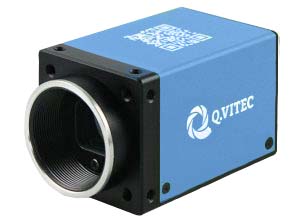
All standard cameras in our product range are fully integrated into our image processing software Vision Q.400, and have naturally been tested too: Connect, configure and you're done.
Our standard cameras are matrix cameras, all of which are furnished with a monochrome or colour sensor. They feature resolution of up to 5MP and are available with both Camera Link® and Gigabit Ethernet interface.
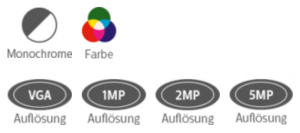
In addition to cameras with matrix sensors, Vision Q.400 also supports line scan cameras or what are referred to as image contact sensors. 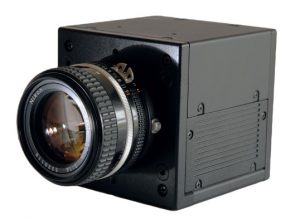 Line scan cameras are used to test continuous products and in cases where the testing tasks require extremely high resolutions, such as when performing surface inspections or when testing textile tracks. Vision Q.400 is able to process images of up to 500 MB. The Q.400XD system can be used to split extremely large flows of information from a single line scan camera across multiple controllers in a synchronised manner.
Line scan cameras are used to test continuous products and in cases where the testing tasks require extremely high resolutions, such as when performing surface inspections or when testing textile tracks. Vision Q.400 is able to process images of up to 500 MB. The Q.400XD system can be used to split extremely large flows of information from a single line scan camera across multiple controllers in a synchronised manner.
One special feature is what are referred to as image contact sensors. In these, the lighting and the image sensor are precisely harmonised with each other. This offers a major benefit in that the time-consuming and often sensitive alignment between camera and lighting can be dispensed with.

GigE cameras The image processing software Vision Q.400 supports multiple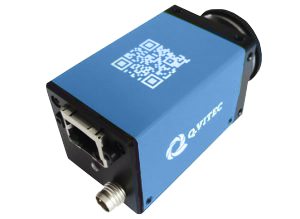
Gigabit Ethernet cameras with a wide range of sensor sizes by different manufacturers such as Baumer, BASLER, Allied Vision, Technologies, MATRIX VISION, JAI, Sony, NET, SVS-VISTEK or Point Grey Research. Vision Q.400 can handle all the parameters required for the GigE Vision standard.* The user interface offers straightforward access to these parameters.
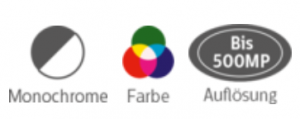
Special systems with special protection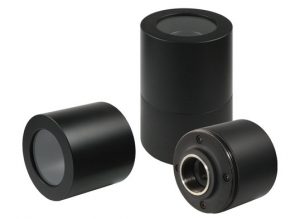
The external conditions for efficient testing procedures are often far from ideal. Sterile laboratory-type conditions only prevail in the rarest of cases. On the contrary, quite frequently it is necessary to deliver excellent results under adverse conditions. Our camera systems are ideally designed to handle such conditions. Combined with a robust enclosure, our systems satisfy protection class IP67 (International Protection). This provides you with a guarantee that our cameras will function perfectly under the harshest of conditions. Oily, dusty or metallic air? No problem. Unaffected by adverse mechanical conditions and delivered dust- and splash-proof to boot, Q.VITEC systems deliver maximum performance under all conditions.
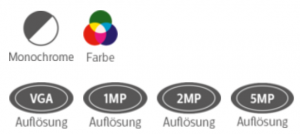
Selecting the camera interface
So how does one choose a suitable camera?
The best way is to ask yourself the following questions:
- Maximum data transfer rate? (resolution x frame rate x bytes per pixel)
- Connection to PC – is a frame grabber required?
- Transmission and delay times (real-time capability)?
- Availability of required cable versions (standard cable, drag chain compatible, screw connection, etc.)?
- Maximum cable length?
Cameras with a CameraLink interface
Using a camera with a CameraLink offers numerous advantages, but it is also associated with a couple of requirements and drawbacks.
Advantages:
- Widespread industry standard for image processing
- High bandwidth up to 650MB/s
- Good real-time capability
- Pre-processing possible in the grabber
Drawbacks:
- High costs (frame grabber, cable)
- Frame grabber partially incompatible with modern PCs (PCIe, etc.)
- Short cable length, max. 10m
- Typical use cases
- Systems with high camera resolution and rapid frame rate
- Systems with a significant real-time capability requirement
- Systems requiring pre-preparation in the grabber
- Link to camera manuals
Cameras with GigE interface
Cameras with a GigE interface offer numerous advantages; in fact, they are ideal for two quite typical applications.
Advantages:
- Very popular standard PC interface – future-proof
- Broad industry standard for image processing
- High compatibility thanks to GigEVision and GenICam standards
- Simple networking of multiple cameras
- High bandwidth to 100 MB/s
- Cable lengths of up to 100m
- Good real-time capability, secure data transfer
Typical use cases
- Systems with multiple cameras and/or long cable lengths
- Systems with high camera resolution and rapid frame rate
